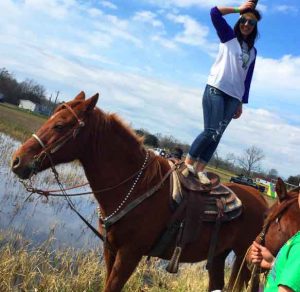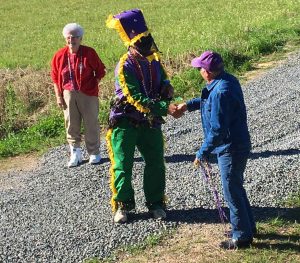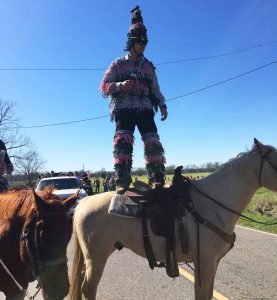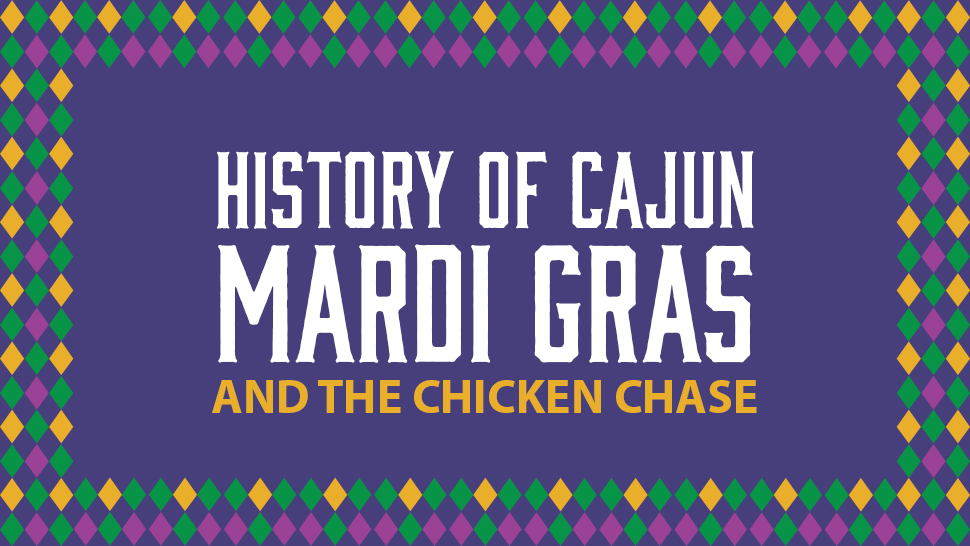When most people think of Mardi Gras, they think of parades, beads, and the French Quarter. For a large part of Louisiana, this isn’t the true Mardi Gras. We’re talking about local Cajun Mardi Gras—complete with a chicken chase!
Cajun Mardi Gras, or Courir de Mardi Gras (Fat Tuesday Run), has been a staple in southern Louisiana for hundreds of years. The tradition dates back to 17th-century Europe; Europeans who settled in the region brought the tradition with them when they arrived.
What is Cajun country?
Cajun country, or Acadiana, is the Southernmost region in Louisiana. The word Acadiana comes from the French Acadians who settled in the area in the 18th century. The Acadians were exiled from Canada and came to Louisiana after the French and Acadian War.
The word Acadiana was never supposed to describe the area; it was purely accidental. In 1963, the President of KATC, the Acadian Television Corporation, wanted to find a good name for the regions surrounding Lafayette, much like ArkLaTex. The company received a misspelled invoice addressed to the “Acadiana Television Corporation,” and the name stuck.
Many Acadiana residents are Cajuns and embody everything that Cajun stands for. While few residents speak French, you can still hear French phrases mixed in with Cajun-accented English. This area is where the true Cajun Mardi Gras magic happens.
A First-Person Perspective of Cajun Mardi Gras
 Lauren Fontenot, a former teller at our Opelousas branch, attended the Courir de Mardi Gras and chicken chase every year. She gave us some insight into its deeply-rooted history:
Lauren Fontenot, a former teller at our Opelousas branch, attended the Courir de Mardi Gras and chicken chase every year. She gave us some insight into its deeply-rooted history:
“Many areas of our state hold on to very rooted Mardi Gras traditions. New Orleans and other metropolitan areas celebrate Mardi Gras by participating in grand parades. We celebrate with a traditional Courir de Mardi Gras in central and south-central rural areas.
The tradition involves masked men in costume riding through the countryside and stopping at houses to beg for food. The group’s captain stops at a house and approaches the owners to ask permission to enter the yard.
 Once the homeowners grant permission, the captain waves his flag so the rest of the men know it’s okay. In exchange for the chicken, rice, onions, or other ingredients, the masked men entertain the homeowners by dancing with them. The masks stay on because guessing who’s behind them is part of the fun.
Once the homeowners grant permission, the captain waves his flag so the rest of the men know it’s okay. In exchange for the chicken, rice, onions, or other ingredients, the masked men entertain the homeowners by dancing with them. The masks stay on because guessing who’s behind them is part of the fun.
At the end of the route, revelers collect the ingredients at a designated spot and partake in a grand community gumbo!
There’s always a trailer with a band or a recording of the traditional Mardi Gras song during the run. The band plays the song the entire time because it tells Mardi Gras’ history. Those in attendance encourage the revelry, drinking, dancing, and chicken chase. It’s the last of this behavior before Fat Tuesday’s end and the Lenten season’s beginning.
I love participating in Courir de Mardi Gras. I grew up around the tradition, and it feels like home to me. Chasing chickens to make a community gumbo sets us apart. When I am on the route listening to the Mardi Gras song, I feel as if nothing else in the world matters!
The History of Cajun Mardi Gras and the Chicken Chase
The Cajun Mardi Gras that Lauren described began in rural medieval France as a celebration of life and community.
According to Barry Ancelet, historian and head of UL Lafayette’s Folklore Department, Cajun Mardi Gras “comes from how Mardi Gras was celebrated in France in the rural section as opposed to the urban carnival. It’s an early springtime renewal and is essentially a way for communities to celebrate and find themselves.”

The celebration includes dancing, drinking, cooking, and begging. The highlight is the fête de la quémande, or feast of begging. Historically, males of medieval French communities would ride on horseback, asking for ingredients for the community meal. The meal would feed the poor residents after a long winter. The wealthy would take pity on the riders and give them the ingredients to create the meal.
In modern Courir de Mardi Gras, women and children participate, and thousands of people flock to Acadiana to join.
On Mardi Gras day, people dress in traditional garb and ride horseback through the city. Residents hand over spices, vegetables, and flour. In return, the beggars sing, dance, and play music.
Occasionally, a homeowner will give the riders a chicken. That’s when the real fun begins.
The owner will throw the live chicken into the crowd for the riders to chase and catch with their bare hands. Some Courir de Mardi Gras celebrations include a chicken chase for the kids.
Cajun Mardi Gras is a “joie de vivre” (French for celebration of life). Every local and tourist should experience the tradition at least once. A deeply rooted history, culture, and passion are alive in Acadiana. The region has a sense of community that seems lost in today’s busy, digital world.
What’s one of your favorite Mardi Gras traditions? Let us know in the comments below!
Lover of writing, learning and teaching others about new things. Proud foodie. Sometimes I mix all of these subjects together.




What is the date of this article? TIA!
Where can I find the chicken chase for Mardi Gras in LaFayette?
Good afternoon Saralynn! Thank you so much for reaching. During Mardi Gras, you can visit tourists websites like https://www.lafayettetravel.com/ to find their calendar of events!